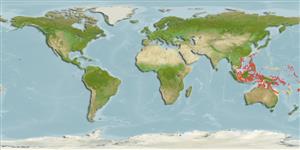>
Gobiiformes (Gobies) >
Gobiidae (Gobies) > Gobiinae
Etymology: Valenciennea: From Achille Valenciennes 1794-1865; he worked with Duméril, Cuvier and Lacepède since 1815; malacologist, author of a "Histoire naturelle des poissons" (Ref. 45335).
Eponymy: Achille Valenciennes (1794–1865) was a French zoologist; primarily an ichthyologist and conchologist. [...] Dr John ‘Jack’ Ernest Randall Jr. [...] (Ref. 128868), visit book page.
More on authors: Hoese & Larson.
Issue
Type locality: Solomon Islands, Guadalcanal, Honiara.
Environment: milieu / climate zone / intervalo de profundidade / distribution range
Ecologia
marinhas; estuarina associadas(os) a recifes; intervalo de profundidade 8 - 30 m (Ref. 48637). Tropical
Western Pacific: Ryukyu Islands, Philippines, Solomon Islands, Malaysia, Palau, Indonesia and the Great Barrier Reef.
Tamanho / Peso / Idade
Maturidade: Lm ? range ? - ? cm
Max length : 16.0 cm SL macho/indeterminado; (Ref. 48637)
Espinhos dorsais (total) : 6 - 7; Raios dorsais moles (total) : 16 - 18; Espinhos anais: 1; Raios anais moles: 16 - 18. Characterized by pale grey body color with red and blue-edged blue-green stripe below eye; faint orange stripe along lower side; third dorsal spine longest and prolonged in adult; rhomboid caudal fin, longer than head; longitudinal scale series 76-81; ctenoid body scales, becoming cycloid below first dorsal fin; head or midline of nape without scales; side of nape with scales extending forward to above middle of operculum; fully scaled pectoral fin base and prepelvic area in adult; depth of body 5.0-5.9 in SL (Ref. 90102).
Body shape (shape guide): fusiform / normal.
Inhabits coastal estuaries and muddy slopes adjacent to algal reef to about 30 meters depth (Ref. 48637). Solitary (Ref. 90102). Found in mud or fine silty sand bottoms, usually in the vicinity of its burrow.
Life cycle and mating behavior
Maturidade | Reprodução | Desova | Ovos | Fecundidade | Larvas
Hoese, D.F. and H.K. Larson, 1994. Revision of the Indo-Pacific gobiid fish genus Valenciennea, with descriptions of seven new species. Indo-Pac. Fish. (23):71 p. (Ref. 8527)
Categoria na Lista Vermelha da IUCN (Ref. 130435: Version 2025-1)
Ameaça para o homem
Harmless
Utilização humana
Ferramentas
Relatórios especiais
Descarregue XML
Fontes da internet
Estimates based on models
Preferred temperature (Ref.
123201): 25.9 - 29, mean 28.2 °C (based on 358 cells).
Phylogenetic diversity index (Ref.
82804): PD
50 = 0.5000 [Uniqueness, from 0.5 = low to 2.0 = high].
Bayesian length-weight: a=0.01023 (0.00477 - 0.02194), b=3.01 (2.83 - 3.19), in cm total length, based on LWR estimates for this (Sub)family-body shape (Ref.
93245).
Nível Trófico (Ref.
69278): 3.2 ±0.3 se; based on size and trophs of closest relatives
Resiliência (Ref.
120179): Médio, tempo mínimo de duplicação da população 1,4 - 4,4 anos (Preliminary K or Fecundity.).
Fishing Vulnerability (Ref.
59153): Low vulnerability (10 of 100).
🛈
Nutrients (Ref.
124155): Calcium = 81.2 [42.3, 159.4] mg/100g; Iron = 0.673 [0.340, 1.195] mg/100g; Protein = 18.7 [16.7, 20.3] %; Omega3 = 0.146 [0.069, 0.252] g/100g; Selenium = 21.7 [11.9, 46.2] μg/100g; VitaminA = 115 [31, 362] μg/100g; Zinc = 2.01 [1.40, 2.90] mg/100g (wet weight);
